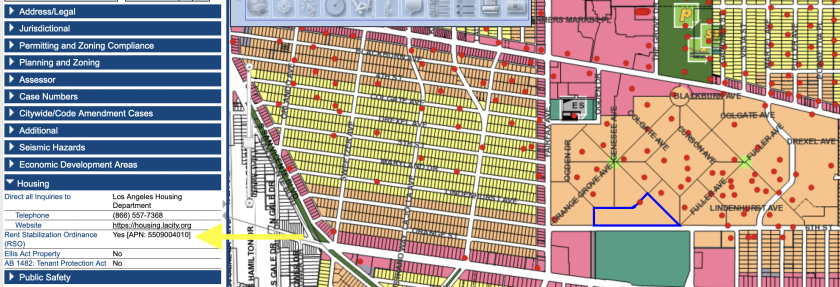Most Los Angeles tenants are protected from any rent increases at their apartments until at least spring 2023. But the rules are confusing and hard to follow. Here’s how to tell if you qualify for the freeze on rent hikes and what regulations remain that may shield you from eviction.
What are the rules?
No tenant living in a rent stabilized apartment in the city of Los Angeles is allowed to have their rent go up right now. Generally, rent stabilized apartments are those that were built before October 1978. More than 650,000 apartments qualify for these protections, nearly three-quarters of L.A.’s apartment stock.
Normally, L.A. landlords are allowed to raise rents on existing tenants in rent stabilized apartments between 3% and 8% annually, depending on inflation. But in March 2020, Mayor Eric Garcetti issued an emergency order in response to the COVID-19 pandemic that halted rent increases in such apartments until a year after the emergency order expires. That order is still in effect, so rent increases cannot begin any earlier than May 2023.
This is the first time in more than four decades that L.A. landlords have been blocked from any increases. They remain able to charge whatever they want for apartments once a tenant vacates.
What if I live in a newer apartment?
Other L.A. tenants may be covered by a state law that caps annual rent increases. This law limits rent hikes to 5% plus inflation. For this year in Los Angeles, the total percentage increase allowed is 8.6%. Generally, this law covers apartments that are older than 15 years that are not otherwise subject to rent control, so apartments that were built between October 1978 and 2007.
If you live in an apartment newer than that, you might qualify for anti-price gouging regulations that limit rent hikes to no more than 10% within a year during declared states of emergencies. You should contact the city to verify if those regulations apply to your situation.
How do I know if I qualify for any of these protections?
The city has a website that tells you: zimas.lacity.org. Type your address in. Then click the tab labeled “Housing” on the left side of your screen. If the screen reads “Yes” for “Rent Stabilization Ordinance” then rent increases are prohibited. If the screen reads “Yes” for “AB 1482: Tenant Protection Act” then you’re covered by the state rent cap.
For example, this is a screen shot after going through these steps for an apartment in Park La Brea, the city’s largest rent stabilized complex.

The city’s zimas.lacity.org website can tell you if your L.A. apartment is covered by rent stabilization.
(zimas.lacity.org)
What if I don’t live in the city of Los Angeles?
Other than Los Angeles, six cities in L.A. County have some form of rent control for older buildings: Baldwin Park, Beverly Hills, Culver City, Inglewood, Santa Monica and West Hollywood. If you live in one of these cities, you should check with your local government to see what the allowable rent increase is this year and whether your building is covered.
Unincorporated L.A. County has rules as well. Like the city of L.A., rent increases this year also are prohibited for covered apartments. Here, rent stabilized apartments are those built before 1995. The county protection against rent hikes is set to last through the end of the year.
Additionally, the state cap on rent increases and anti-price gouging rules applies to all apartments older than 15 years if they’re not under rent control.
What about evictions?
At the beginning of the pandemic, many cities put into place protections against eviction for those whose incomes or health were affected by COVID-19. Many of those safeguards have now gone away, but some remain. In the city of Los Angeles, qualifying renters have a year after the expiration of the mayor’s emergency order to pay back rent that accrued during the pandemic before being evicted. So that means tenants now have until at least May 2023 to repay.
Elsewhere in L.A. County, the situation is more complicated. Except for the cities of L.A., Beverly Hills and Pasadena, which have their own rules, tenants can be evicted for unpaid rent now unless they or their landlord have a pending application for the state’s rental assistance program. If that’s the case, evictions are not allowed until July 1.
For city of Los Angeles questions, contact the Los Angeles Housing Department at housing.lacity.org; (866) 557-7368.
For L.A. County questions, contact Los Angeles County Consumer and Business Affairs at dcba.lacounty.gov; (800) 593-8222.
Stay Housed L.A., a joint project of the city and county, also offers resources: stayhousedla.org; (833) 223-7368.
